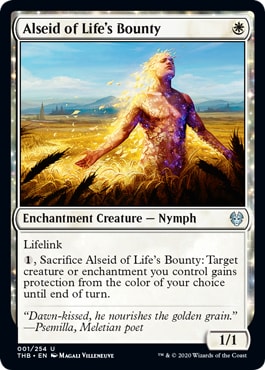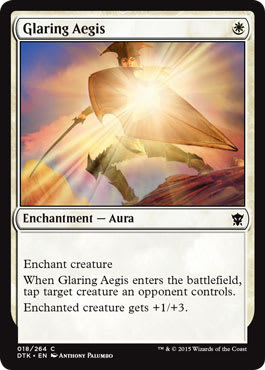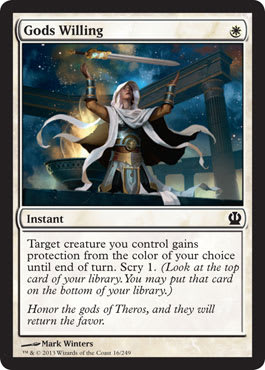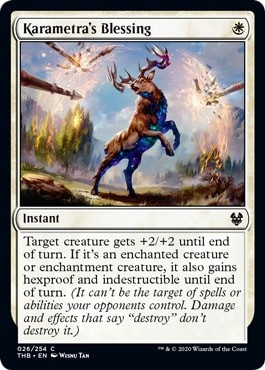-William Shakespeare
Lurrus White Weenie?
Standard White Weenie?
Standard no-Bogles Bogles?
I think last week we called it "Mono-White Auras".
I have no idea what name is going to stick-stick for this deck; only that I am really glad I encountered it writing last week. For purpose of this discussion, I am working from the 11_and_me version discussed in Cheating on Lurrus of the Dream-Den:
Mono-White Auras | IKO Standard | 11_and_me, 7th Place Standard Challenge 5/17/2020
- Companion (1)
- 1 Lurrus of the Dream-Den
- Creatures (13)
- 1 Hushbringer
- 4 Alseid of Life's Bounty
- 4 Healer's Hawk
- 4 Stonecoil Serpent
- Instants (8)
- 4 Gods Willing
- 4 Karametra's Blessing
- Enchantments (18)
- 2 Sentinel's Mark
- 4 All That Glitters
- 4 Glaring Aegis
- 4 Sentinel's Eyes
- 4 Solid Footing
- Lands (21)
- 20 Plains
- 1 Castle Ardenvale
How Does This Deck Work?
You start with whatever you drew. And if you didn't draw anything; you should throw it back for six. Generally speaking I'll lead on Healer's Hawk first, followed by Alseid of Life's Bounty, and Stonecoil Serpent only if I don't have another first turn option.
The game will be de facto decided on turn two more often than you might imagine. Healer's Hawk has the strongest evasion attacking on turn two, which is why it gets the preferential nod on turn one. Alseid has work to do, is often jumping around between the graveyard and the battlefield (but not actually doing much battling) so you don't necessarily want to commit enchantments to it. Stonecoil Serpent's ceiling is potentially quite high so you don't necessarily want to waste that on a 1/1 body if you have other options.
One potential wrinkle on that depends on what Companion (if any) your opponent reveals before you make your first turn play. If you read them for a deck that plans to control the battlefield with Teferi, Time Raveler and / or Deafening Clarion, you might want to run a turn one or turn two Stonecoil Serpent. Once you're past turn two, it's almost the end game believe it or not!
Okay... We said that the game will often be decided on turn two, right? What did we mean by that? Even Keruga, the Macrosage decks will usually have interaction on turn two, in the form of Bonecrusher Giant - sorry Stomp - and Brazen Borrower (or rather, it's other half, Petty Theft). Whatever creature you lead on, you will have to be mindful of the opponent's ability to disrupt your game plan on turn two.
The most common procedure will be to use one mana to buff your creature, and leave up one mana for one of your Negates. If your "Negate" is an Alseid of Life's Bounty, you'll probably only be attacking for one damage. But there is little more satisfying than the opponent waiting for your attack (or responding to your Sentinel's Eyes or Solid Footing) and catching them with a Karametra's Blessing. Take 100, am I right? Way to steal their turn three as well, if they were trying to defend themselves with Brazen Borrower or Bonecrusher Giant!
Procedurally, this deck will often play more like a Counter-Sliver deck than a straightforward creature attack deck. Instead of building power with Slivers going wide, you tend to build 1-2 threats going tall with loads and loads of buff spells. Stonecoil Serpent is an excellent attacker (or attacker-defender with Sentinel's Eyes or Sentinel's Mark); but the deck gains its most powerful advantages when slamming an opponent who actually cares about reducing you to zero with a large lifelinker. The thing that makes this strategy so good is its ability to attack the format opportunistically.
Against many other creature decks, it almost can't be beat. They're doing their fair thing; you're doing your slightly smaller thing... And gaining enough life to make their life miserable with every attack. Decks like Mono-Red Obosh and Boros Lurrus are overwhelmingly positive matchups.
Similarly, there are some decks that are just trying to take a big turn. Some of those big turns you can do nothing about; if you're up against a Migratory Greathorn deck and they go wide and / or luck into an End-Raze Forerunners you're very likely dead. Or, you had to beat them up with lifelink enough to not be dead AND get them close enough that you can end it before they finish you on the swing back. But some big turns you can invalidate for one mana. The most important one in Standard is turning a token into an Agent of Treachery with Lukka, Coppercoat Outcast. If all they're doing on turn five is trying to steal your Companion or giant Healer's Hawk, you will usually untap and kill them. If they're doing three things... You might still untap and kill them but it's at least twice as complicated to get there.
More than any other deck in Standard, I feel like White Weenie is best explained via SWOT. So that's what I'm going to do.
Strengths (helpful, internal)
If you're going to slam with Mono-White Auras, it's probably not because the deck is strong. Rather, it's because the deck is opportunistic.
Everyone has a plan [at least until they get punched in the face]. This deck has a pretty cogent one. Get big. Go tall. Put the opponent into a narrow situation reaction-wise. Drawing two copies of All that Glitters can be shockingly effective.
The deck can be the absolute master of combat. If it's you against blockers, you against life total, you can just get in unblocked with Alseid of Life's Bounty or Gods Willing and race. While this is only a good Lurrus of the Dream-Den deck, when it's working, it feels like playing solitaire. Sacrificing Alseid of Life's Bounty is one of a relatively narrow band of permanents you can actually control putting into the graveyard, but playing it back up allows you to get past two different colors of blockers.
Again, lifelink.
Again, Stonecoil Serpent can simply invalidate many lines of defense.
Weaknesses (harmful, internal)
The single most important weakness of this deck is that if the opponent has a creature that beats you in some other way than directly interacting with one of your creatures, attacking, or blocking... It pretty much isn't going anywhere. For example, if you're at a point in the game that the opponent can operate Kenrith, the Returned King, you can lose just to the life gain option. Another good example is Gemrazer. You might be able to beat the first Gemrazer with a Gods Willing or Karametra's Blessing, but the problem with Gemrazer is that they might be getting a trigger every turn; this can tear up all your offensive auras and reduce you to an actual weenie deck.
Perhaps related to this weakness is that you have almost no ability to control your draw. Most of your card advantage comes from Lurrus of the Dream-Den rather than actually drawing up, so not only do you have a ceiling based on your graveyard, you're bound by mana. For instance, in the mirror match, mana development early is one of the most important things because it allows you to deploy, trade, and work your Lurrus.
Opportunities (helpful, external)
This is an "Opportunities" deck if there ever was one. You don't play White Weenie - or at least this White Weenie - because you think it's the most powerful deck. You play it because it's positioned to thrash popular decks, or at least popular decks that aren't prepared for you.
Boros Cycling? They have almost no chance. Even if they get the fast aggro Fox draw (you know, basically drawing a Fox) it is difficult for them to race because of your lifelink. It's even worse for Mono-Red. Boros isn't killing any of your creatures early, but while the Red Deck can, they probably have a two-point ceiling at Shock or Stomp.
You don't have the pure offensive speed of Zvi's StOmPy deck, but you have a much better capability to hold a lead, especially if the opponent is trying to control your side of the battlefield with point removal.
Threats (harmful, external)
In-line with Opportunities, this deck will thrive only based on opponents' deck selections. If Shatter the Sky - like playing lots of copies of Shatter the Sky - becomes popular, that's very bad for this deck. Unlike a Modern Bogles deck, the creatures in this one don't naturally have Hexproof, so playing an overabundance of point removal can kill all your creatures (ultimately leaving you with a bunch of pump spells). For instance, I think the worst matchup is the Orzhov quasi-mirror. If the opponent who also has a Lurrus of the Dream-Den [but one you can't remove] and is alternately running Dead Weight and Mire's Grasp... Your guys are all going to be deck, probably starting with your Lurrus to completely imbalance the battlefield.
Also, this deck can be really bad against multiple classes of Green creature ramp strategies. Migratory Greathorn into End-Raze Forerunners? You probably can't stop them from executing their plan. Kaheera Fires? That's an exciting matchup! You better win quickly, because your chip-shot-race baseline is probably going to be outclassed once they start spitting out free 7/7s.
Update?
Lurrus Weenies | IKO Standard | MarySue, 5th Place MTGO Standard Challenge 5/24/2020
- Companion (1)
- 1 Lurrus of the Dream Den
- Creatures (14)
- 3 Healer's Hawk
- 3 Stonecoil Serpent
- 4 Alseid of Life's Bounty
- 4 Gingerbrute
- Instants (6)
- 2 Gods Willing
- 4 Karametra's Blessing
- Enchantments (20)
- 4 All That Glitters
- 4 Glaring Aegis
- 4 Season of Growth
- 4 Sentinel's Eyes
- 4 Solid Footing
- Lands (21)
- 2 Forest
- 7 Plains
- 2 Castle Ardenvale
- 2 Fabled Passage
- 4 Temple Garden
- 4 Temple of Plenty
- Sideboard (14)
- 4 Devout Decree
- 2 Giant Killer
- 2 Hushbringer
- 3 Light of Hope
- 2 Soul-Guide Lantern
- 1 Warbriar Blessing
I haven't tried this version yet, but I thought it was worth mentioning... If not for the Green splash, but rather the inclusion of Gingerbrute. The Mono-White version can of course play Gingerbrute, which would give the deck an additional 1-drop (and actually a very relevant one).
Gingerbrute getting in consistently is something that can be attractive in the mirror especially. So, I suppose, load it up with auras.
Tactics and Closing Thoughts
Alseid of Life's Bounty + Glaring Aegis
While the lack of removal is one of this deck's key weaknesses, it can control the battlefield somewhat via Glaring Aegis. A cute play you can make is to put Glaring Aegis on your Alseid of Life's Bounty and then sacrifice it to put both cards into the graveyard; you can then re-play the Glaring Aegis with Lurrus of the Dream-Den. This sequence might allow you to get past three different colors of blockers, or to get past some artifact creatures, like an opposing Stonecoil Serpent.
Gods Willing v. Karametra's Blessing
On average Gods Willing is the weakest card in the main deck. Not only does it not have much text in some matchups, unlike Karametra's Blessing it doesn't boost damage; and it can actually be detrimental in some circumstances. Like against another White creature deck, you can accidentally cause some of your auras to fall off.
But the card does have utility, and in some circumstances even more relevant text than Negate peer, Karametra's Blessing.
I just wanted to share a small error I made this week and hopefully it will help you to win more! In an end game situation my opponent attacked me with both of his Bonecrusher Giants, but not for lethal damage. I assumed he had two different kinds of interaction in hand, otherwise I figured he'd leave at least one Giant back.
So I swung in with my hella lethal Castle Ardenvale token. Arbitrarily large (relative to how much it actually had to do), but not lifelink. He threw a Brazen Borrower Adventure at the token. Almost automatically I threw my Gods Willing at it. Almost immediately I realized my mistake! He followed up with Frilled Mystic. I completed the stack with a Karametra's Blessing to still stop the Petty Theft, but to no avail. The Mystic hit the battlefield, chumped; and I lost to the Bonecrusher Giants the next turn.
What happened here?
I didn't need the additional damage; so holding the Karametra's Blessing for the opponent's second answer didn't get me anything. What is more important is that both cards can counter a targeted spell, but Gods Willing could also prevent a block. Had I led with the Blessing, the opponent would still have cast his Frilled Mystic; but when I responded with Gods Willing in this alternate universe, I would have both prevented the Petty Theft and prevented the Mystic chump.
Trample
None of that would have mattered had my token simply had trample, right?
The most surprising thing I learned testing this deck is how much trample matters! This deck doesn't have much trample, but many of the folks who take games off of it do. I've lost quasi-mirrors to Shadowspear, and more than one duel to big Green decks with End-Raze Forerunners. But the most important trampler to think about - with and against - is Stonecoil Serpent.
Stonecoil Serpent isn't just potentially very big and very trample... It's colorless so your pseudo-trample coming from Gods Willing or Alseid of Life's Bounty won't let you get around it.
Finally, to repeat the non-buried lede: I think White Weenie is the best strategy! (at least for now)
LOVE
MIKE





























